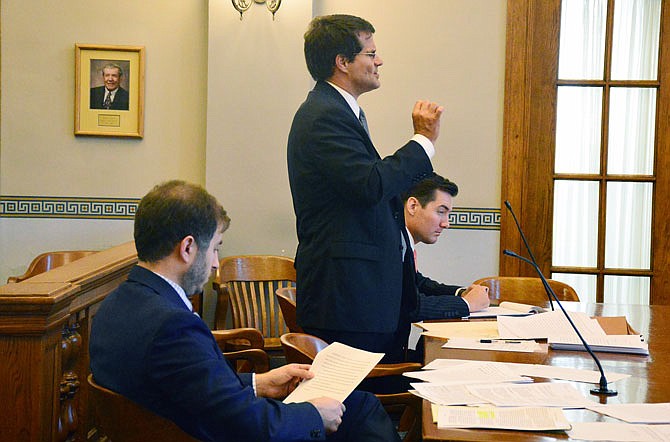It all boils down to what the words mean or how they're interpreted.
Cole County Circuit Judge Jon Beetem said Thursday he'll consider how to rule in a case questioning Gov. Mike Parson's power to fill the vacant lieutenant governor's job - but he didn't say when he'd issue that ruling.
During a nearly 55-minute hearing, Missouri Solicitor General D. John Sauer told Beetem that Parson had complete constitutional authority when he named state Sen. Mike Kehoe as the state's number-two office holder last month.
But St. Louis lawyer Matt Vianello, who filed the lawsuit challenging that appointment just hours after Kehoe took the job June 18, told Beetem the Missouri Constitution and state laws don't give the governor that authority.
Both sides agree one key provision is the Constitution's Article IV, Section 4, which reads: "The governor shall fill all vacancies in public offices unless otherwise provided by law "
Vianello argued: "I think the most reasonable interpretation of that is, 'The governor has the legal authority to appoint unless the law says he doesn't have the legal authority to appoint.'"
And, he said, Article VII, Section 7 says: "Except as provided in this constitution, the appointment of all officers shall be made as prescribed by law."
Add to that the law now on the books as Section 105.030: "Whenever any vacancy occurs or exists in any state or county office originally filled by election of the people, other than in the offices of lieutenant governor, state senator or representative, sheriff the vacancy shall be filled by appointment by the governor."
Read together, the two constitutional provisions and the law "limit the governor's authority to appoint a lieutenant governor," Vianello said. "That is the only interpretation that gives meaning" to all three provisions - "and his reported appointment of Sen. Kehoe would be invalid."
But, Sauer countered, since the Constitution uses the phrase "otherwise provided by law" in Article IV, Section 4, Parson had the authority "unless the law furnishes or supplies another manner or another way in which that vacancy may be filled."
Since neither the Constitution nor state laws provide any specific method of filling a lieutenant governor's vacancy, Sauer explained, "That is the only plain, ordinary and natural meaning of that particular constitutional provision."
Both sides agree no state law provides specific direction on how a governor is to fill a vacancy in the lieutenant governor's job.
"At the very least, one would expect the Legislature to speak very clearly if it was taking away that very clearly granted authority," Sauer argued.
But the appointment was not authorized, Vianello said.
Instead, he said, the court should declare Parson didn't have the authority in the first place - and that the lieutenant governor's job should remain vacant until voters fill it in the 2020 elections, unless the Legislature changes the law before then.
Vianello said two Supreme Court rulings - in 1912 and 1977 - understood the lieutenant governor's office would remain vacant until the next election, once a vacancy occurred.
Vianello filed the lawsuit on behalf of the Missouri Democratic Party and an individual, Darrell Cope, of Hartville, who is a World War II veteran arguing he's directly affected by how the lieutenant governor's office is filled because the lieutenant governor's office has authority over programs for senior citizens and veterans.
The state argued they don't have the legal right to bring the suit, since Kehoe's appointment already occurred, making him a de facto statewide official who then can be removed from office only by a court ruling on a lawsuit filed by the attorney general or a local prosecutor.
And, because Kehoe now holds one of the six statewide official positions, he only can be removed through impeachment.
But, Vianello countered, that shouldn't apply "if the governor didn't have authority to appoint in the first place."
Beetem asked both sides to provide him with proposed orders and any other legal arguments by today.

